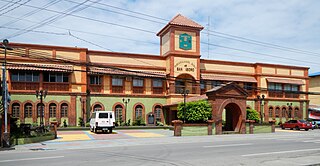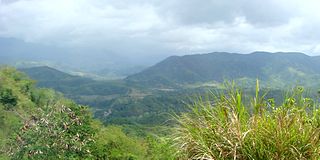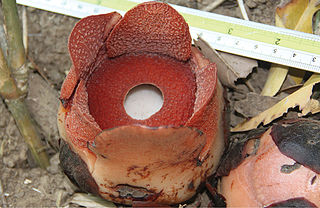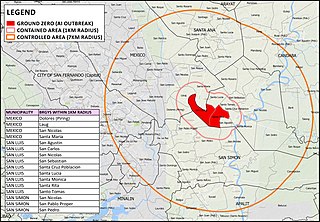
Rafflesia, or stinking corpse lily, is a genus of parasitic flowering plants in the family Rafflesiaceae. The species have enormous flowers, the buds rising from the ground or directly from the lower stems of their host plants; one species has the largest flower in the world. Plants of the World Online lists up to 41 species from this genus, all of them are found throughout Southeast Asia.

Amorphophallus is a large genus of some 200 tropical and subtropical tuberous herbaceous plants from the Arum family (Araceae), native to Asia, Africa, Australia and various oceanic islands. A few species are edible as "famine foods" after careful preparation to remove irritating chemicals. The genus includes the Titan arum of Indonesia, which has the largest inflorescence of any plant in the genus, and is also known as the 'corpse flower' for the pungent odour it produces during its flowering period, which can take up to seven years of growth before it occurs.

Nueva Ecija, officially the Province of Nueva Ecija, is a landlocked province in the Philippines located in the Central Luzon region. Its capital is the city of Palayan, while Cabanatuan, its former capital, is the largest local government unit (LGU). Nueva Ecija borders, from the south clockwise, Bulacan, Pampanga, Tarlac, Pangasinan, Nueva Vizcaya and Aurora. The province is nationally known as the Rice Granary of the Philippines, producing the largest rice yield in the country.

Aurora, officially the Province of Aurora, is a province in the Philippines located in the eastern part of Central Luzon region, facing the Philippine Sea. Its capital is Baler and borders, clockwise from the south, the provinces of Quezon, Bulacan, Nueva Ecija, Nueva Vizcaya, Quirino, and Isabela.

Central Luzon, designated as Region III, is an administrative region in the Philippines. The region comprises seven provinces: Aurora, Bataan, Bulacan, Nueva Ecija, Pampanga, Tarlac, and Zambales; and two highly urbanized cities, Angeles and Olongapo. The region contains the largest plain in the country and produces most of the country's rice supply, earning itself the nickname "Rice Granary of the Philippines". It is also the region to have the most number of provinces.

Gapan, officially the City of Gapan, is a 4th class component city in the province of Nueva Ecija, Philippines. According to the 2020 census, it has a population of 122,968 people.

San Isidro, officially the Municipality of San Isidro, is a 2nd class municipality in the province of Nueva Ecija, Philippines. According to the 2020 census, it has a population of 54,372 people.

Gabaldon, officially the Municipality of Gabaldon, is a 3rd-class municipality in the province of Nueva Ecija, Philippines. According to the 2020 census, it has a population of 38,958 people.

Cabiao, officially the Municipality of Cabiao, is a 1st class municipality in the province of Nueva Ecija, Philippines. According to the 2020 census, it has a population of 85,862 people. Cabiao is the 3rd most populous, one of the richest, and fastest growing municipality in the province, only behind Talavera and Guimba. If cities are included, the town ranks 6th.

Cabanatuan, officially the City of Cabanatuan, is a 1st class component city in the province of Nueva Ecija, Philippines. According to the 2020 census, it has a population of 327,325 people, making it the most populous city in Nueva Ecija and the fifth-most populous in Central Luzon.

Peñaranda, officially the Municipality of Peñaranda, is a 4th class municipality in the province of Nueva Ecija, Philippines. According to the 2020 census, it has a population of 32,269 people.

Palayan, officially the City of Palayan, is a 5th class component city and capital of the province of Nueva Ecija, Philippines. According to the 2020 census, it has a population of 45,383 people, making it the least populated city in the Philippines.

Bongabon, officially the Municipality of Bongabon, is a 2nd class municipality in the province of Nueva Ecija, Philippines. According to the 2020 census, it has a population of 66,839 people.

Pantabangan, officially the Municipality of Pantabangan, is a 1st class municipality in the province of Nueva Ecija, Philippines. According to the 2020 census, it has a population of 31,763 people.

Zaragoza, officially the Municipality of Zaragoza, is a 3rd class municipality in the province of Nueva Ecija, Philippines. According to the 2020 census, it has a population of 53,090 people.

Rafflesia consueloae is a parasitic plant species of the genus Rafflesia endemic to the island of Luzon in the Philippines. It is the smallest species of the genus Rafflesia.

From April to September 2017 in the Philippines, an outbreak of H5N6 avian influenza or bird flu affected poultry in at least three towns in Central Luzon; San Luis in Pampanga and Jaen and San Isidro in Nueva Ecija.

Aurelio Matias Umali is a Filipino politician from the third district of Nueva Ecija, Philippines. Umali is the youngest elected governor in the province since his first government office position. He currently serves as a Governor of Nueva Ecija. He was a governor for three terms from 2007 to 2016 and was re-elected in 2019.
The Philippine Taxonomic Initiative (PTI) is a private Philippine research institute and non-profit organization founded in 2018, located in the Philippines.
Nueva Ecija's at-large congressional district was the provincewide electoral district of Nueva Ecija for Philippine national legislatures before 1987.

















